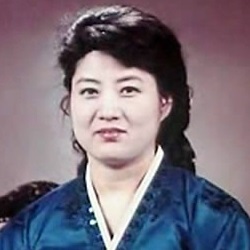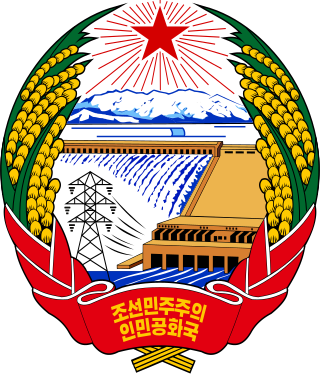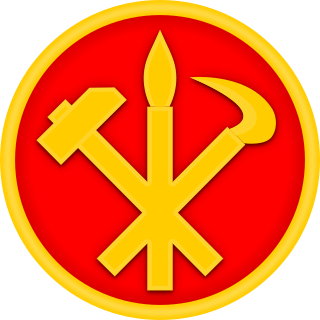
Juche, officially the Juche idea, is the state ideology of North Korea and the official ideology of the Workers' Party of Korea. North Korean sources attribute its conceptualization to Kim Il Sung, the country's founder and first leader. Juche was originally regarded as a variant of Marxism–Leninism until Kim Jong Il, Kim Il Sung's son and successor, declared it a distinct ideology in the 1970s. Kim Jong Il further developed Juche in the 1980s and 1990s by making ideological breaks from Marxism–Leninism and increasing the importance of his father's ideas.

Ko Yong Hui, also spelled Ko Young-hee, was the mistress of North Korean supreme leader Kim Jong Il and the mother of his successor, Kim Jong Un. Within North Korea, she is only referred to by titles, such as "The Respected Mother who is the Most Faithful and Loyal 'Subject' to the Dear Leader Comrade Supreme Commander", "The Mother of Pyongyang", and "The Mother of Great Songun Korea".

Kim Il Sung University (Korean: 김일성종합대학) is a public university in Taesong, Pyongyang, North Korea. Founded on 1 October 1946, it is the first institution of higher learning in North Korea since its foundation.
The Mansudae Art Troupe is a North Korean troupe of musicians that create light-classical operas and music, as well as dance pieces.
The Communist movement in Korea emerged as a political movement in the early 20th century. Although the movement had a minor role in pre-war politics, the division between the communist North Korea and the anti-communist South Korea came to dominate Korean political life in the post-World War II era. North Korea, officially the Democratic People's Republic of Korea, continues to be a Jucheist state under the rule of the Workers' Party of Korea. In South Korea, the National Security Law has been used to criminalize advocacy of communism and groups suspected of alignment with North Korea. Due to the end of economic aid from the Soviet Union after its dissolution in 1991, due to the impractical ideological application of Stalinist policies in North Korea over years of economic slowdown in the 1980s and receding during the 1990s, North Korea continues to nominally uphold Communism, but has replaced Marxism-Leninism with the Juche idea. References to Communism were removed in the North Korean 1992 and 1998 constitutional revisions to make way for the personality cult of Kim's family dictatorship and the North Korean market economy reform. The Workers' Party of Korea under the leadership of Kim Jong Un later reconfirmed commitment to the establishment of a communist society, but orthodox Marxism has since been largely tabled in favor of "Socialism in our style". Officially, the DPRK still retains a command economy with complete state control of industry and agriculture. North Korea maintains collectivized farms and state-funded education and healthcare.

Kim Il Sung Square is a large city square in the Central District of Pyongyang, North Korea, and is named after the country's founding leader, Kim Il Sung. The square was constructed in 1954 according to a master plan for reconstructing the capital after the destruction of the Korean War. It was opened in August 1954. The square is located on the foot of the Namsan Hill, west bank of the Taedong River, directly opposite the Juche Tower on the other side of the river. It is the 37th largest square in the world, having an area of about 75,000 square metres which can accommodate a rally of more than 100,000 people. The square has a great cultural significance, as it is a common gathering place for concerts, rallies, dances and military parades and is often featured in media concerning North Korea.

The Workers' Party of Korea (WPK) is the sole ruling party of the Democratic People's Republic of Korea, commonly known as North Korea. Founded in 1949 from a merger between the Workers' Party of North Korea and the Workers' Party of South Korea, the WPK is the oldest active party in Korea. It also controls the Korean People's Army, North Korea's armed forces. The WPK is the largest party represented in the Supreme People's Assembly and coexists with two other legal parties that are completely subservient to the WPK and must accept the WPK's "leading role" as a condition of their existence. The WPK is banned in the Republic of Korea under the National Security Act and is sanctioned by the United Nations, the European Union, Australia, and the United States.

Kim Il Sung was a North Korean politician and the founder of North Korea, which he led as Supreme Leader from the country's establishment in 1948 until his death in 1994. Afterwards, he was succeeded by his son Kim Jong Il and was declared Eternal President.

The Mansudae Art Studio is an art studio in Pyeongcheon District, Pyongyang, North Korea. It was founded in 1959, and it is one of the largest centers of art production in the world, at an area of over 120,000 square meters. The studio employs around 4,000 people, 1,000 of whom are artists picked from the best academies in North Korea. Most of its artists are graduates of Pyongyang University. The studio consists of 13 groups, including those for woodcuts, charcoal drawings, ceramics, embroidery and jewel paintings, among other things.

Chairman Mao badge is the name given to a type of pin badge displaying an image of Mao Zedong that was ubiquitous in the People's Republic of China during the active phase of the Cultural Revolution, from 1966 to 1971. The term is also used for badges associated with Mao that do not actually have a picture of him on them. It is estimated that several billion Chairman Mao badges were produced during the period of the Cultural Revolution.
The award system of the Democratic People's Republic of Korea was initially created less than one month after the foundation of the Republic. During the years of Japanese occupation of Korea, many of the future leaders fled to the Soviet Union. During World War II many if not close to all party leaders and Korean People's Army commanders served in the Soviet Army and as such adopted many of the Soviet awards criteria for their own. During the late 1940s and until the Sino-Soviet Split in late 1958, orders and titles were made in the Soviet Money Mints in Moscow or Leningrad. Soviet made awards were modeled after Soviet orders and made of sterling silver. Initially the orders were attached to clothing with a screw-plate, but after Soviet production stopped, production was moved to North Korea. The screwback was replaced with a pin and the silver content was replaced with cheap tin. With the exception of a few examples of modern orders, Soviet and Czech KPA awards are the most sought after in current militaria markets.

The North Korean cult of personality surrounding the Kim family has existed in North Korea for decades and can be found in many examples of North Korean culture. Although not acknowledged by the North Korean government, many defectors and Western visitors state there are often stiff penalties for those who criticize or do not show "proper" respect for the former leaders of the country, Kim Il Sung and Kim Jong Il, officially referred to as "eternal leaders of Korea". The personality cult began soon after Kim Il Sung took power in 1948, and was greatly expanded after his death in 1994.

In North Korea, the Political Bureau of the Central Committee of the Workers' Party of Korea (WPK), or simply the Politburo, formerly the Political Committee (1946–61), is the highest decision-making body in the ruling party between sessions of its Central Committee. Article 25 of the Party Charter stipulates that "The Political Bureau of the Party Central Committee and its Standing Committee organize and direct all party work on behalf of the party Central Committee between plenary meetings. The Political Bureau of the Party Central Committee shall meet at least once every month." The Politburo is elected by the Central Committee of the Workers' Party of Korea.

The Secretariat of the Workers' Party of Korea, formerly known as the Executive Policy Bureau (2016–21), manages the work of the Politburo of the Workers' Party of Korea and its Presidium. The General Secretary leads the work of the Secretariat, and the body is composed of several members.

The Mansu Hill Grand Monument is a complex of monuments in Pyongyang, North Korea. There are 229 figures in all, commemorating the history of the revolutionary struggle of the Korean people, and especially their leaders. The central part of the monument consists of two 22-meter-tall (72 ft) bronze statues of Kim Il Sung and Kim Jong Il.

The Day of the Sun is an annual public holiday in North Korea on 15 April, the birth anniversary of Kim Il Sung, founder and Eternal President of North Korea. It is the most important national holiday in the country, and is considered to be the North Korean equivalent of Christmas. Kim's birthday, which had been an official holiday since 1968, was renamed Day of the Sun in 1997, three years after his death. The name takes its significance from his name: Il-sung.

The Order of Kim Jong Il is a North Korean order named after Kim Jong Il, the former leader of North Korea. It is the highest order of North Korea, along with the Order of Kim Il-Sung, and only second to one honorary title, the Hero of Labour.

Visual depictions of Kim Il Sung have been commonplace in North Korea since the 1940s following the example of Joseph Stalin in the Soviet Union and Mao Zedong in China. The display of Kim Il Sung portraits was made mandatory at homes in the 1970s. In the past, they were mandatory in certain public places as well, such as factories, airports, railway stations, and rail and subway carriages. At present, they no longer appear in means of transport, not even in some new buildings. Portraits of Kim Jong Il have been hung next to Kim Il Sung since the late 1970s. A portrait of Kim Jong Un was displayed for the first time in public in 2018.

The Propaganda and Agitation Department, officially translated as the Publicity and Information Department, is a department of the Central Committee of the Workers' Party of Korea (WPK) tasked with coordinating the creation and dissemination of propaganda in North Korea. It is the highest propaganda organization in the country.




















